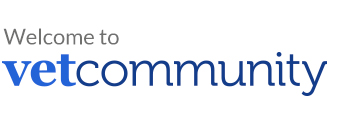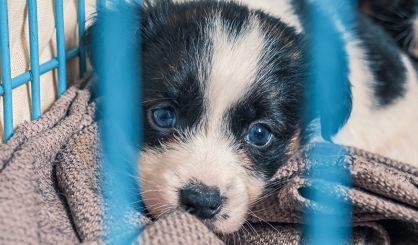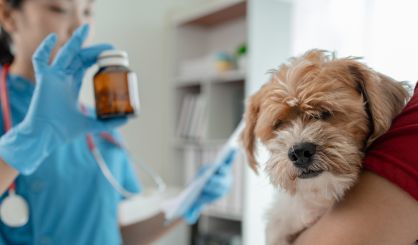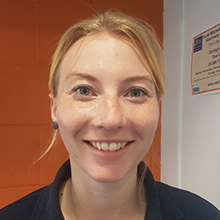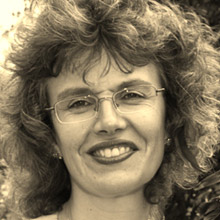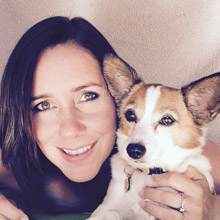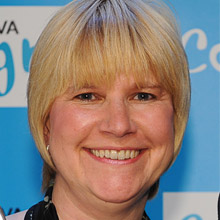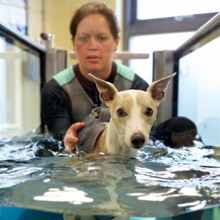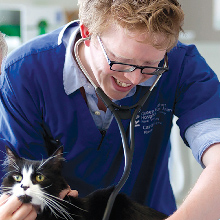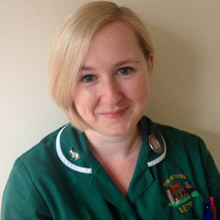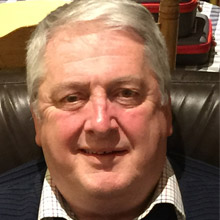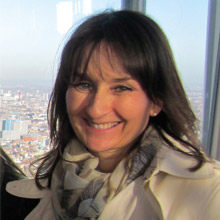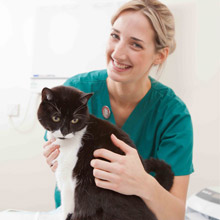Clinical Abstracts and blogs
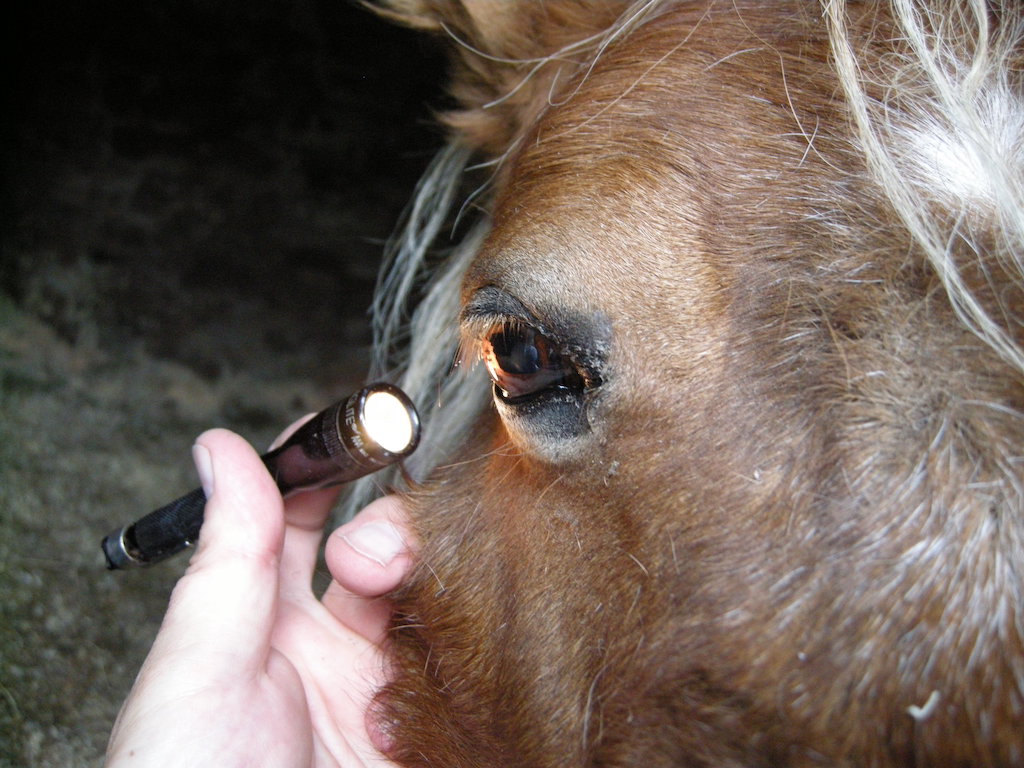
Eye problems in the horse
The size and prominence of the equine eye means that disease and injury to the eye are common occurrences. Many...
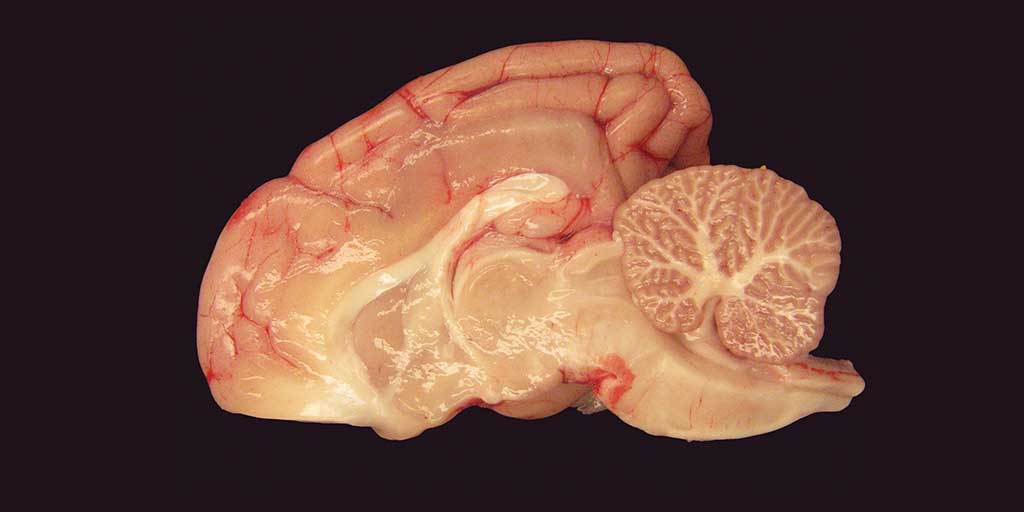
Locating neurological lesions
Whilst neurology is an area of specialisation, most neurological lesions initially present in first opinion practice. Therefore, every general...

Common calving problems
The objectives for managing a cow at calving should be the same regardless of whether the cow is in a...
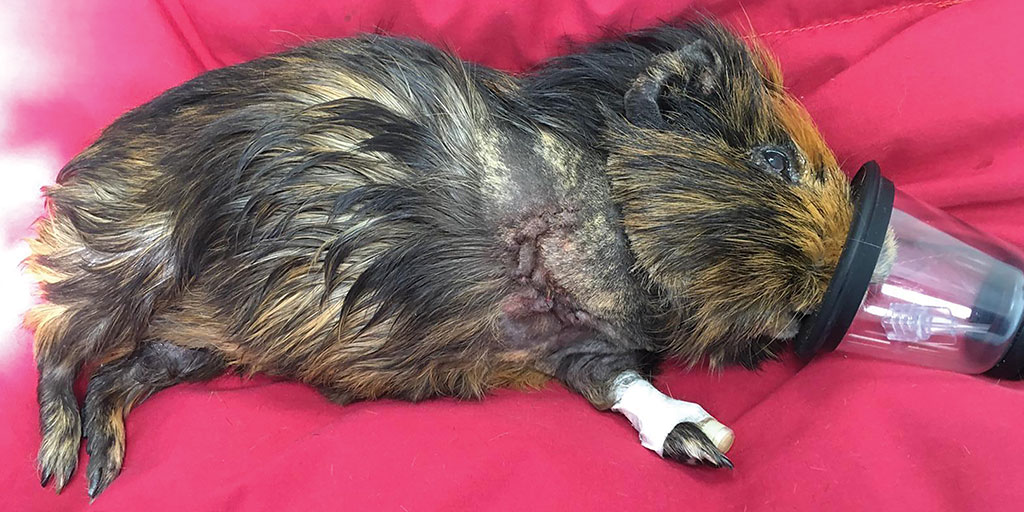
A forelimb amputation in a guinea pig with osteomyelitis
Guinea pigs are commonly-owned, exotic small mammals and present frequently to veterinary surgeons in general practice. Small mammal limb injuries...
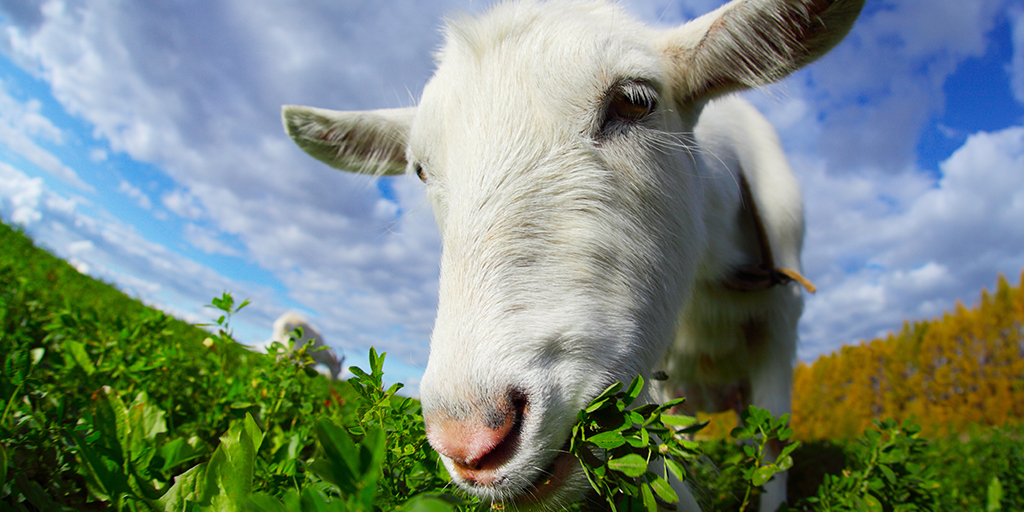
Poisoning – the bigger picture: pigs, sheep, goats and horses
The Veterinary Poisons Information Service answer enquiries about any animal – big or small – and although larger animals represent...
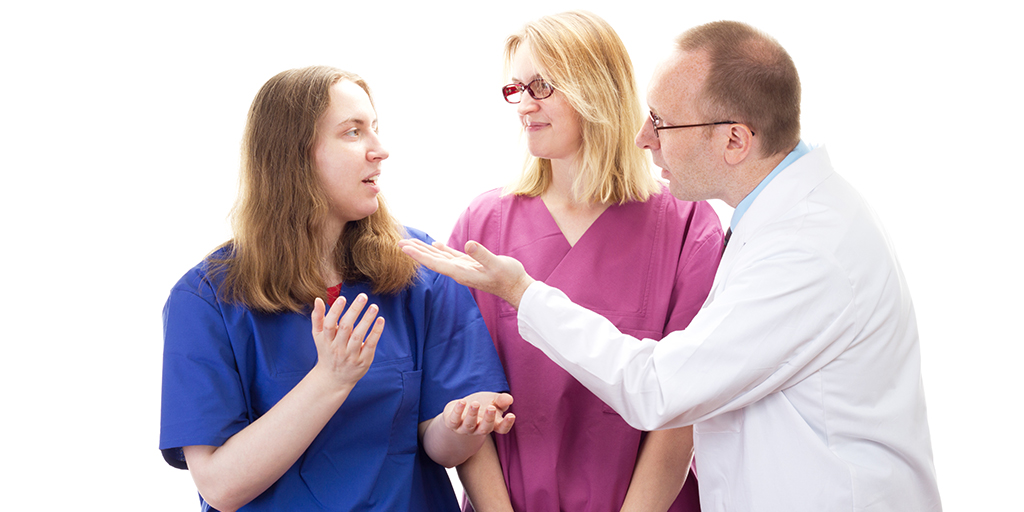
Team member disputes – managing difficult employment relationships before they affect the wider practice
Stephenie Malone, specialist employment solicitor at Harrison Clark Rickerbys solicitors, discusses team member disputes in the veterinary practice. Difference and...
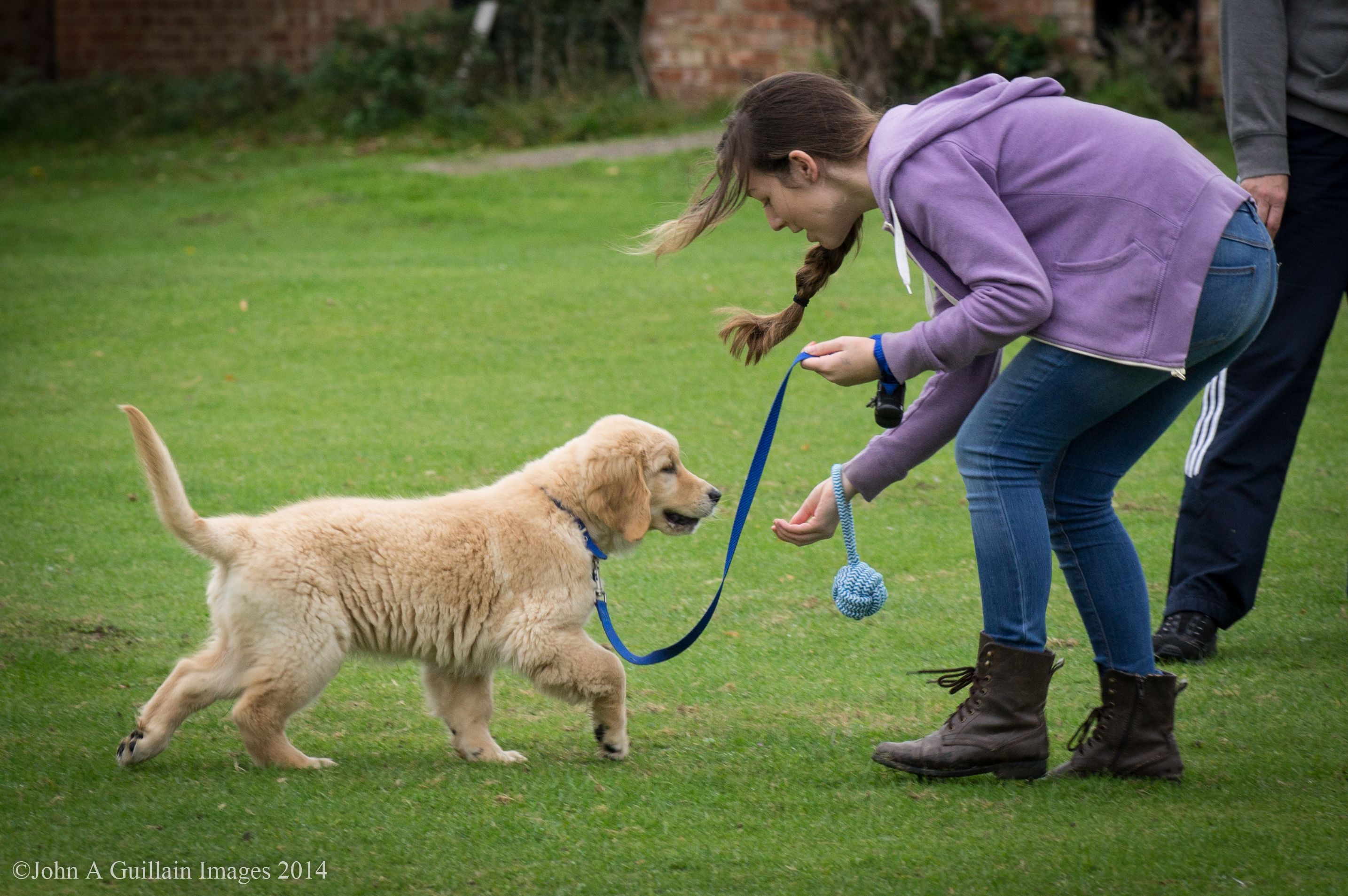
Whom to choose? Clearing confusion about appropriate behaviour and training referral services
In this article, Karen Wild, ASAB-Certificated Clinical Animal Behaviourist, explores the options for veterinary surgeons, veterinary nurses and owners regarding the...

London Zoo opens spa-inspired capybara home
London Zoo has welcomed a pair of capybaras to a brand new, spa-inspired home at the conservation zoo.
Gizmo and Kiwi, a brother-sister duo, were introduced to their permanent home last week after a stay in their balmy indoor bathing pool.
The capybaras were originally only planned to take a temporary ‘city-break’ at London Zoo. However, having settled in well, the organisation decided to build them a permanent new home.
The spa-inspired pad includes two pools, mud-bath wallows and climate-controlled zones.
Kiwi was the first to explore her new home, trotting outside ahead of her brother into their luxury new home. Although Gizmo was more reluctant to face the chilly air, he was soon outside with his sister.
The siblings inspected every corner of their new home, stopping only to enjoy the morning sun.
Capybaras, the world’s largest rodents, are semi-aquatic, with their scientific name translating to ‘water pig’. Their physiology includes partially-webbed feet, with eyes and nostrils located at the top of their head like a snorkel.
Gizmo and Kiwi are adept swimmers, and so London Zoo visitors will be able to see the pair demonstrating their skills in the outdoor pool, which is naturally filtered by bulrushes. Their new home also features an indoor, heated bathing pool which helps keep their skin moisturised.
After their swim, the capybaras can head to their climate-controlled indoor zone to bask under UV lamps and enjoy some peace and quiet.
The capybaras will also take part in daily training sessions with their keepers, which also supports the care team to perform basic health checks.
Visitors at London Zoo can now see both Gizmo and Kiwi in their new home.
Image © Tim Whitby/ZSL
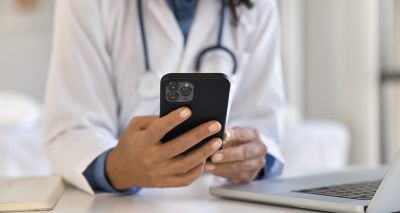
RCVS announces 1CPD app update
The update will make it easier for users to record their continuing professional development.
The RCVS has announced a new version of its 1CPD mobile app, with enhanced features for veterinary surgeons and veterinary nurses to record their continuing professional development.
The mobile app includes a new ‘what would you like to do?’ shortcut for frequent tasks, a notification badge, and the ability to scan a QR code from the home screen to easily record an activity.
Users will be prompted to update the app from the App Store or Google Play the next time they log in. For more information, visit RCVS.org.uk
Image (C) Fizkes/Shutterstock.com

Nominations open for RCVS and VN Council elections
Veterinary surgeons and veterinary nurses can now put themselves forward.
The nomination period for the 2026 RCVS Council and VN Council elections is now open, with three veterinary surgeon seats and two veterinary nurse seats available.
Prospective candidates can download an information pack and nomination form from the RCVS website. Individuals can nominate themselves for the elections, with the results to be announced in the spring.
Clare Paget, the recently appointed RCVS Registrar and elections returning officer, said: “If you want to play your part in influencing and moulding how the professions are regulated, and making key decisions on matters of great importance to your peers, the public and animal health and welfare, please consider standing for RCVS Council or VN Council next year.”
Nominations close at 5pm on Saturday, 31 January 2026.
Image (C) RCVS.
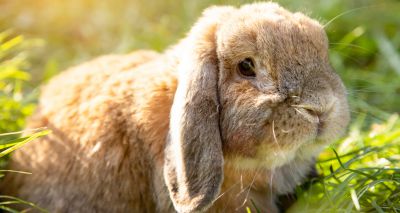
Lop-eared rabbits at risk of hidden ear disease, study shows
A study from the Royal Veterinary College (RVC) has confirmed that lop-eared rabbits are at the highest risk of hidden ear diseases.
RVC’s latest discovery confirms previous research, which had initially suggested that lop-eared rabbits might be more susceptible to ear disease. However, these studies had relied on small samples, retrospective clinical records and owner reports.
Although ear disease is widely recognised in rabbits, their health problems can often go unnoticed since they rarely display signs of discomfort. This can mean issues such as excessive ear wax, narrowed ear canals, and early signs of ear disease can go unnoticed without veterinary examination.
In this study, researchers conducted a large, systematic assessment of how ear shape and head shape might relate to ear abnormalities. This was intended to provide both veterinary surgeons and rabbit owners with a more robust understanding of the condition.
Between October 2023 and February 2024, RVC Rabbit Welfare Research Assistants examined 435 pedigree rabbits volunteered by British Rabbit Council (BRC) breeders. Researchers travelled to BRC shows and breeding studs, where they recorded rabbits’ ear type, head shape, estimated adult bodyweight, age, and other features.
They then performed a structured otoscopic examination, which saw them examine the outer ear, the diverticulum and the full length of the external ear canal for signs of inflammation, narrowing, discharge or crusting.
By linking these examinations with statistics, the team compared ear health across 49 breeds to link conformations with specific ear abnormalities.
Lop-eared rabbits were found to be more likely to show nine of the 11 abnormalities assessed. This included ear canal narrowing, abnormal colour, flaky and wet discharge, behavioural reactivity, dermatological changes to the pinna, and crusts in the diverticulum.
Such abnormalities indicate painful inflammation or infection to the outer ear canal, which can seriously impact welfare.
Head shape was also indicative of potential ear problems, however this was not as consistent as with ear shape. For example, brachycephalic rabbits had narrower ear canals, while dolichocephalic rabbits might get more crusts in the diverticulum.
Body size was similarly relevant, with heavier rabbits most likely to display redness, narrowing, flaky discharge, traumatic pinna changes and strong behavioural reactions to examination.
Maria Jackson, Rabbit Welfare Research Assistant at RVC and lead author, said: “Our findings have once again shown that rabbits with lop ears are more likely to develop ear problems – specifically, signs of otitis externa – than rabbits with upright ears. Rabbit owners should take their rabbit for regular veterinary examinations, where the ears will be checked with an otoscope for hidden signs of disease.
“Anyone owning a lop-eared rabbit must be especially vigilant for subtle signs of ear pain, such as scratching the ears or shaking the head more than normal, and general lethargy or withdrawal.”
The full study can be found in the Veterinary Journal.
Image © RUl8let/Shutterstock

RSPCA launches charity appeal as neglect cases rise
The RSPCA has launched an urgent charity appeal, after reports revealed a 30 per cent increase on pet neglect cases compared to 2024.
Up until the end of October, the charity’s emergency line received 73,294 reports of neglect in England and Wales.
This latest finding follows data released by RSPCA last month, which found that animal abandonment has similarly risen this year. Incidents reported to the RSPCA increased by 23 per cent in the first 10 months of the year, totalling 24,270 incidents by the end of October.
In response to these statistics the RSPCA has launched The Big Give Back to Animals.
The urgent appeal calls for donations to support the RSPCA team to cope with rising demands for help. This includes the charity’s rescue efforts, veterinary care, specialist behavioural training, and day-to-day care.
Alongside its daily animal rescue work, the RSPCA says it is committing extra funding to crisis measures, including a cost-of-living hub and expanded pet food bank partnerships.
Simon Osborne, RSPCA superintendent, said: “Animals are facing shocking levels of neglect right now - they are often starving behind closed doors and being left without the treatment they urgently need. The truth is, times are desperately tough – and innocent animals are tragically the ones paying the ultimate price.
“The heartbreaking surge in neglect reports has already shattered our records, and we fear for what is to come over the winter months.
“These are not just statistics; behind the staggering numbers are individual animals, all who desperately need and deserve our help to survive. It’s unbearable to see the pain in their eyes but that’s the reality facing our so many animals and our rescuers fighting to save their lives.”
Donations to RSPCA’s Big Give Back to Animals can be made here.
Image © RSPCA
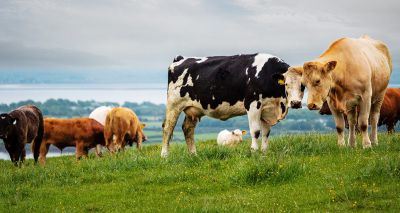
Bluetongue confirmed in Northern Ireland cattle herd
The Department of Agriculture, Environment and Rural Affairs (DAERA) has confirmed two cases of bluetongue in cattle on a premises in County Down.
Investigations have also revealed a further 44 cattle which could be infected with the viral disease.
Although bluetongue poses no threat to public health or food safety, it can severely damage the health of many hooved animals. Among its symptoms are ulcers, breathing difficulties, lameness and stillbirths.
The disease is non-contagious, but does spread through insects such as biting midges.
Biting midges are most active from April to November, with lower temperatures reducing the risk. Recent surveillance has identified active midges in the locality of the infected premises.
As a result of the diagnosis, DAERA has now set out plans to conduct further testing on farms within the 20km Temporary Control Zone (TCZ), which was introduced 29 November.
DAERA minister Andrew Muir has confirmed that he has briefed his Irish Government counterpart Martin Heydon on their findings. DAERA has also said it is engaging with Ulster Farmers Union and others in the wider industry.
Minister Muir said: “The results of this preliminary testing is undoubtedly a blow for the owners and staff on the farm which operates to the highest biosecurity standards and our thoughts are with them at this time. It is also hugely disappointing for the agri-food sector which up until now has enjoyed bluetongue free status in Northern Ireland.
“It is important that I reiterate that bluetongue poses no threat to public health nor to food safety. It is spread by midges and recent surveillance has identified active midges in the locality. However, given the impact on farm animals, it is a threat we must take seriously.”
Brian Dooher, DAERA chief veterinary officer, added: “While the affected farm remains restricted, the Temporary Control Zone will also remain in place to limit any possible spread to or from other holdings.
“The focus of DAERA vets is now on surveillance testing of herds within the 20km Temporary Control Zone to ascertain if there has been further infection in livestock outside the holding.”
Farmers within the TCZ are urged to familiarise themselves with restrictions and remain vigilant for signs of bluetongue in flocks or herds. Any concerns should be reported to a local Divisional Veterinary Office or to the DAERA helpline (0300 200 7840).
Image © mark gusev/Shutterstock.com
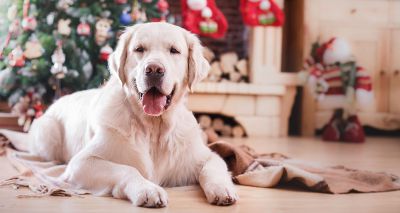
BSAVA PetSavers launches Christmas appeal
Every donation before 31 December will be doubled.
BSAVA PetSavers, the charitable arm of the British Small Animal Veterinary Association, has launched its 2025 Christmas Appeal.
This year’s campaign invites UK animal lovers to donate towards the organisation's life-changing research into pet health.
Crucially, any donation will be matched by supporters VetPlus, Sustain Insurance Brokers and NationWide Laboratories, meaning every donation made by the public will be matched.
Alison Selby, fundraising manager for BSAVA PetSavers explained: “We are thrilled to have the support of VetPlus, Sustain Insurance Brokers and NationWide Laboratories this Christmas. Their generous match funding means that every £1 donated by the public will be doubled at no extra cost to the donor – generating twice the impact for pet health.
“The research we fund covers areas as diverse as cancer, heart disease, neurological disorders, gastrointestinal disease and many more. By supporting our Christmas Appeal, you will be helping our pets live longer, happier, healthier lives.”
Alina Zheleznyakova, head of marketing and communications at NationWide Laboratories added: “At NationWide Laboratories, we’re proud to support BSAVA PetSavers Christmas Appeal. Their commitment to advancing small animal health through clinical research and education mirrors our own values.
“By backing this initiative, we’re helping ensure that veterinary professionals have the resources they need to improve the lives of pets across the UK. It’s a chance to double the impact of every donation and make a real difference this festive season.”
Cristina Secura from Sustain Insurance Brokers concluded: "We’re proud to partner with PetSavers this Christmas. Supporting the wellbeing of pets and their owners aligns perfectly with our values, and we’re excited to help raise awareness and funds for this important cause."
Image (C) Anna Averianova/Shutterstock.com
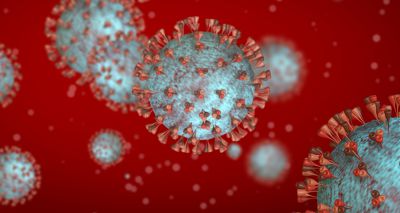
Avian flu viruses can withstand fever, study reveals
PB1 gene helps infection to persist under high temperatures.
New research has shown that bird flu viruses can replicate at temperatures higher than a typical human fever, making them potentially more dangerous to people.
The study, led by the universities of Cambridge and Glasgow with involvement from the Roslin Institute, found that a gene of the virus, known as PB1, plays a crucial role in determining viral sensitivity to temperature.
Until now, researchers have not fully understood how fever prevents viruses, or why some viruses can survive high temperatures.
Professor Paul Digard of the Roslin Institute said: “These findings offer useful insight into the potential of flu viruses to cause severe infection in humans, and an understanding of the science underlying this threat.
“This aids our understanding of the relative risks of various flu types, and how we might best manage the fever response associated with viral infections.”
The study, published in Science, builds on evidence that some flu viruses can thrive in relatively high temperatures. For example, the lower respiratory tract and the guts of some birds can reach 40-42C.
Using mice, the team showed that fever protected flu viruses of human origin, with a two degrees celcius increase in body temperature. However, avian flu viruses resisted the fever and still caused severe illness.
Researchers also discovered that viruses carrying an avian-like PB1 gene could withstand fever temperatures, and caused severe disease. This is significant because human and bird flu viruses can swap genes when both viruses infect their host.
Dr Matt Turnbull University of Glasgow explained: “The ability of viruses to swap genes is a continued source of threat for emerging flu viruses. We’ve seen it happen before during previous pandemics, such as in 1957 and 1968, where a human virus swapped its PB1 gene with that from an avian strain. This may help explain why these pandemics caused serious illness in people.
“It’s crucial that we monitor bird flu strains to help us prepare for potential outbreaks. Testing potential spillover viruses for how resistant they are likely to be to fever may help us identify more virulent strains.”
Image (C) Hi Clicker/Shutterstock.com
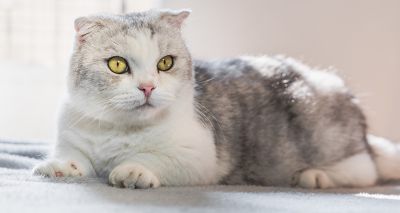
Cats Protection shares 'urgent' welfare concerns for extreme cats
Cats Protection has shared ‘urgent’ concern for the welfare of extreme purebred cats, following a review in collaboration with Royal Veterinary College (RVC).
In its review, which the charity describes as ‘the first of its kind’, researchers identify welfare risks that they believe contravene UK animal welfare legislation.
The document considers the five welfare needs, as detailed in UK legislation, alongside feline quality of life assessment tools. This is used to evaluate the impact of extreme traits and husbandry practices.
The review highlighted that extreme conformations, such as brachycephaly and dwarfism, are linked with issues that contravene Animal Welfare Acts. This includes chronic pain, impaired mobility, respiratory compromise and behaviour limitations.
Brachycephalic breeds, including Persians, displayed an increase risk of ocular, dental and respiratory pathology. Meanwhile Scottish Folds may experience osteochondrodysplasia.
Similarly it warns that emerging designer breeds, such as the XL bully cat (a hybrid cat combining the Sphynx and the Munchkin), may be of concern due to their multiple extreme traits.
There were also ethical and welfare questions, based on the behavioural challenges and lack of suitability for domestic environments synonymous with some hybrid cats. Poor breeding practices could also contribute to stress, infectious disease transmission and poor early socialisation.
Researchers have called for the end of breeding cats with folding ears, which they believe pose a clear welfare compromise. Instead they recommend evidence-based breeding in which traits are selected based on welfare impact.
They suggest that research into the welfare impacts of extreme traits should continue, alongside improved regulation of breeding establishments and more public education to address misconceptions about health and behaviour. They also call for collaborative efforts, involving academics, the veterinary profession, the government, animal charities and breeding organisations.
Veterinary professionals are being encouraged to recognise welfare concerns, support clients in making informed decisions when choosing a purebred cat, and advocate for policy change and responsible breeding standards.
Dan O’Neill, professor of companion animal epidemiology at RVC and co-author of the study, said: “This paper draws parallels for cats with the well-documented welfare crisis in brachycephalic dogs and urges the veterinary sector to apply lessons learned there to dissuade owners from acquiring cats with extreme conformation”.
The full study can be found in the journal Animal Welfare.
Image © Anciens Huang/Shutterstock.com
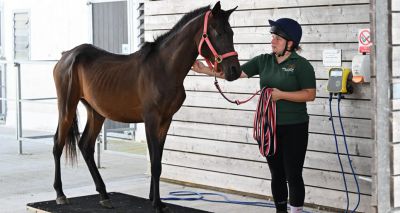
Appeal launched after horse found dangerously underweight
Two-year-old Bourbon weighed around 120kg less than expected.
A South-West animal welfare charity has launched its Christmas appeal after taking in a dangerously underweight horse.
The Mare and Foal Sanctuary says the discovery of Bourbon, in a remote, barren field in Cornwall, highlights the challenge of equine welfare as the cost-of-living crisis continues to bite.
The two-year-old Arab colt had been living on hard, compacted ground, with mud underfoot, with very little to graze on. When he was found by the Sanctuary’s team, he was drastically underweight, with his hips and ribs clearly visible, and a dull, lacklustre coat.
He was assessed by the Beech Trees Veterinary and Welfare Centre in Newton Abbot, who found that he weighed around 120kg less than expected for a horse of his age, breed and type.
Vets quickly devised a structured recovery plan, including a gentle feeding programme with fibre-based feeds, unlimited hay and controlled access to grass to avoid colic. But despite the intensive support, Bourbon still struggled to build weight.
Senior field officer Leah Brock said: “Blood tests showed that his liver wasn’t functioning properly, and we believe it was damaged. We started a supplement regime to help his liver to heal.”
Vets also investigated a subtle head tilt with x-rays and neurological exams, checking his neck mobility, limb placement and tails response to rule out serious nerve problems.
Despite his challenges, Bourbon is said to have an amazing temperament and is thriving on human interaction.
Horse care team member Georgina Ballard said: “He’s very gentle and sweet. You wouldn’t know he hadn’t had much handling. Aside from not picking up his feet or leading initially, he behaves like a well-handled horse, with no fear of humans.”
Bourbon will continue his recovery on one of the Sanctuary’s sites with a herd of young horses.
The Mare and Foal Sanctuary provides confidential, non-judgemental advice to anyone struggling with their equine. This December, as many families continue to juggle the rising cost of living, the charity is appealing for donations to continue their support for Bourbon and other equines facing similar hardships.
For more information and to make a donation, visit mareandfoal.org/bourbon
Image (C) The Mare and Foal Sanctuary.
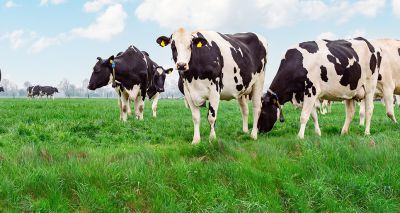
Northern Ireland fears first ever bluetongue outbreak
Veterinary surgeons from the Department of Agriculture, Environment and Rural Affairs (DAERA) are investigating a suspected case of bluetongue in Northern Ireland.
Active surveillance from DAERA has indicated the presence of the disease in two cows at a holding near Bangor in County Down.
As of 29 November, a 20km Temporary Control Zone has been implemented around the premises. This also prohibits the movement of susceptible species, including cattle, sheep and goats, on or off the premises.
If confirmed, this case could lead to the Northern Ireland’s first ever outbreak of bluetongue.
The last time that bluetongue was reported in Northern Ireland was December 2018, in an imported heifer from France. It had been detected as part of a post-import testing regime.
However this was not confirmed as an outbreak, since there was no evidence that the disease was circulating.
The import of infected animals or germplasm is the most likely route of disease entry to Northern Ireland. As such, all breeding and production animals must be isolated and restricted on farms until DAERA is assured bluetongue is not present.
Post-import testing has been extended to all susceptible animals imported from BTV-affected countries. DAERA urges farmers to think carefully before importing cattle from bluetongue affected areas.
The 20km Disease Control Measure forms part of a Disease Control Framework, launched in June. Brian Dooher, chief veterinary officer for DAERA, says the organisation is also working with colleagues in the Republic of Ireland to co-ordinate a response.
Dr Dooher said: “I would urge all farmers to ensure they source their animals responsibly. The spread of bluetongue could have a significant impact on livestock and the rural economy.
“Furthermore, all livestock owners should remain vigilant for signs of the disease. It is imperative that keepers report any symptoms immediately to their vet, local Divisional Veterinary Office or to the DAERA helpline on 0300 200 7840.”
Andrew Muir, DAERA minister, said: “In the face of these suspected cases, my officials are taking all the necessary steps to protect the agri-food industry. I urge everyone in the industry to play their part as well and especially appeal to those in the Temporary Control Zone to follow the restrictions.
“My department is working closely with all stakeholders, including colleagues in GB and the Republic of Ireland, to monitor the situation.”
Image © Jannissimo/Shutterstock.com
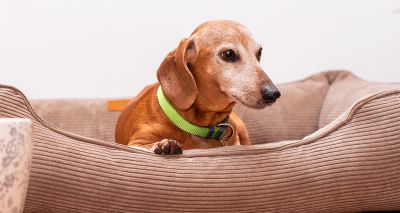
RVC introduces new treatment for canine heart condition
The Royal Veterinary College (RVC) has become the first centre in the world to offer a new treatment for dogs with degenerative mitral valve disease (DMVD) alongside open-heart surgery and medical treatment.
The new treatment option, trans-catheter edge-to-edge repair (TEER), is minimally-invasive and is now available at the RVC’s Queen Mother Hospital for Animals (QMHA).
DMVD causes the mitral valve to thicken and become leaky, and so blood will flow backwards into the heart’s left atrium. This means the heart chambers will enlarge, often resulting in heart failure.
The condition is most frequent in smaller, older dogs. Although it is incurable, it is managed with medication and treatment to extend life.
The introduction of TEER, which is a relatively new procedure, is the result of collaboration between QMHA’s Cardiology Service and Bristol Veterinary Specialists. The procedure is undertaken using specialist equipment, including the hospital’s echo machines.
The surgery is minimally invasive, which allows surgeons to repair the mitral valve on a beating heart. Dogs are mobile the following day and are usually discharged within two days.
TEER is offered alongside open-heart surgery under cardiopulmonary bypass, which is still considered the most effective therapy for advanced cases of DMVD.
However, researchers suggest that TEER may be recommended to patients unsuitable for open-heart surgery, those requiring a less invasive approach, and those with financial limitations. It is also recommended to dogs with severe mitral regurgitation caused by DMVD, heart enlargement or a history of congestive heart failure.
Joshua Hannabuss, lecturer in veterinary cardiology and co-head of cardiology at RVC’s QMHA, said: "It's truly exciting to offer an additional treatment option for dogs with degenerative mitral valve disease. I believe we’re entering a new era where minimally invasive therapies will become more accessible for managing this condition.
“With a clearer understanding of the safety, benefits and potential risks of TEER, we feel that now is the right time to introduce this therapy to the UK, and we remain committed to improving the quality and longevity of life for dogs affected by this disease."
Image © Tymoshenko Olga/Shutterstock.com

RUMA Agriculture shares new AMR targets for livestock sectors
The Responsible use of Medicines in Agriculture Alliance (RUMA Alliance) has shared a set of targets intended to reduce antimicrobial usage (AMU) in the UK’s livestock sectors.
The third cycle of targets from its Targets Task Force (TTF3) sets out commitments for each of the livestock sectors from 2025 until 2029.
Produced in line with the government’s AMR National Action Plan, this latest cycle forms a part of an ongoing voluntary initiative to reduce antibiotic use in the sector. Now in its ninth year, the initiative has recorded a 57 per cent reduction in antibiotic use in livestock sectors and an 83 per cent reduction in HP-CIA use.
In its latest report, RUMA Agriculture sets out a summary of TTF3 targets for each of the livestock sectors. It also provides an overview of its other AMU activities and projects.
This includes targets for cattle, sheep, pigs and poultry, with details of its own steps for each sector.
For some sectors, the TTF3 says that sustainable levels of use have been reached, and so it has held its previous targets. It explains that these targets have been based on realism, where it is more sensible to maintain low use rather than seeking lower reductions.
For other sectors, while target setting has been impacted by differing levels of data, the TTF3 says that levels of commitment and focus has remained evident.
However, the TTF3 also warns of the continuing challenge that vaccine availability poses a continuing challenge to its goals. RUMA Agriculture has collaborated with the Veterinary Medicines Directorate on the Statement of Intent on UK Veterinary Vaccine Availability, which it says will support farmers’ access to necessary vaccines.
It also reflects on the impacts of climate change, which is particularly damaging to outdoor farming, and disease outbreaks like bluetongue and avian influenza.
Cat McLaughlin, chair of RUMA Agriculture, said: “RUMA Agriculture has always held true to its mantra of ‘as little as possible, as much as necessary’, and I think we should stress that over the next TTF period, this remains a relevant principle.
“Reductions in antibiotic use can only be made by balancing the health needs of animals under our care with a functioning and sustainable agricultural sector.
“We will continue to need antibiotics in our health toolbox, but we also need vaccines, skilled and dedicated stock people and vets, and a supportive farming infrastructure around us.”
In response to the report Abi Seager, CEO at the VMD, said: “VMD welcomes the third set of targets, which reflect the sectors’ long-standing commitment to tackle AMR and continuing their journey of responsible antibiotic stewardship, since the establishment of the RUMA Targets Task Force in 2016.
“We look forward to the ongoing collaboration between industry and government to improve animal health and antibiotic stewardship.”
The TTF3 targets report, and all previous TTF reports, can be accessed here.
Image © RUMA

Sector welcomes government's VSA commitment
Veterinary organisations have welcomed an announcement from the UK government, committing to a consultation on the Veterinary Surgeons Act 1966.
The commitment, made during the chancellor Rachel Reeves’ Budget Statement, could see a consultation published this year on potential reforms.
The Veterinary Surgeons Act 1966 has been a topic of discussion among the veterinary sector for many years. It has featured heavily in the Competition and Markets Authority (CMA) investigation, and has been the subject of campaigns from organisations including the British Veterinary Association (BVA) and the Federation of Independent Veterinary Practices (FIVP).
Many veterinary organisations support a reform of the Veterinary Surgeons Act, which has been described as ‘outdated’ and unsuitable for the modern veterinary industry.
The BVA explains that the current Veterinary Surgeons Act regulates veterinary surgeons and RVNs, but not veterinary practices. This means that individuals may be held accountable for business decisions outside of their control.
The Act has been further criticised for its approach to veterinary nurses. Both BVA and the British Veterinary Nursing Association (BVNA) have called for the ‘veterinary nurse’ title to be protected, preventing those without qualifications using the title.
It also does not recognise other members of the veterinary team, including technicians and other professionals.
Responding to the chancellor’s announcement, BVA president Rob Williams said: “BVA has been pushing for reform of the outdated Veterinary Surgeons Act for many, many years and in recent months we’ve worked closely with Defra on what reformed legislation could look like.
“It’s therefore extremely positive to see the government once again committing to reform in the chancellor’s Budget Statement today and with the consultation expected to launch in the coming weeks, I strongly encourage veterinary colleagues to engage with the process, ensure their voices are heard and help us grasp this opportunity to shape a veterinary sector that is fit for the 21st century.”
Meanwhile RCVS president Tim Parkin said: “Having been calling for urgent reform to the VSA for many years, this is very encouraging news and, perhaps, even an early Christmas present from the chancellor.”
He added: “At nearly 60 years old, the VSA does not give the RCVS the powers or flexibility necessary to be a modern regulator fit for purpose in the 21st century. It’s time for change.
“Being in the unique position of being a Royal College that regulates, we very much look forward to hearing more detail from Defra about this consultation in due course, and would encourage members of the veterinary professions and public alike to respond.”
Image © RCVS
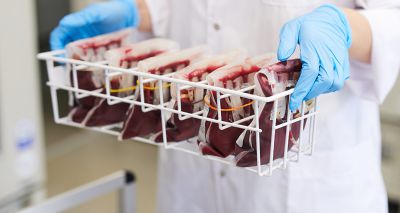
Pet Blood Bank makes 'urgent' appeal for donor dogs
Pet Blood Bank UK has issued an urgent appeal for dogs across the country to donate life-saving blood to help dogs this winter.
As colder weather approaches, the charity has reported a sharp drop in appointments and an 18 per cent drop in donor registrations. However demand continues to rise, meaning supplies are at their lowest level this year.
It estimates that approximately 800 units of blood will be needed to meet the demand for blood donations this winter.
The charity is now calling on dogs to attend donation sessions across the country. It says that every blood donation has the potential to save up to four other dogs.
Canine blood donations can be used to treat a number of medical emergencies, including severe illnesses, accidents and life-threatening injuries.
To be eligible as a blood donor, dogs must be over 25kg and aged between one and eight years. They must also be fit, healthy, confident and happy to meet new people.
Blood donations only take about 10 minutes, however owners should expect the full appointment to last 35-40 minutes.
As part of the appointment, all donor dogs receive a full health check from a Pet Blood Bank UK veterinary surgeon. They also receive a goody bag and a toy.
To register a dog as a blood donor, pet owners should visit the Pet Blood Bank UK website or call 01509 232222.
Image © AnnaStills/Shutterstock.com

Petplan reveals winners of Veterinary Awards 2025
The winners of the 2025 Petplan Veterinary Awards have been revealed, in a ceremony at this year’s London Vet Show.
The event saw Westport Veterinary Clinic score two major awards, with two other independent practices also presented with accolades.
The Veterinary Awards, which is in its 26th year, received over 41,000 nominations of veterinary professionals from clients and colleagues. Three finalists were selected in each category, with the overall winners announced on Thursday, 20 November.
Petplan’s Practice Manager of the Year was named as Fiona Leathers, who manages Westport Veterinary Clinic at South Queensferry.
Mrs Leathers, who qualified as a registered veterinary nurse (RVN) in 2002, joined Westport Veterinary Clinic in 2018. Alongside her role as director of operations, she is also a clinical coach, meaning she is involved with training all student veterinary nurses.
She has previously been recognised as The Blue Cross Veterinary Nurse of the Year, and is also the first RVN to hold the position of chair at Scottish charity Vet Trust Ltd.
Westport Veterinary Clinic has also been recognised in the Practice Support Staff of the Year category. Hannah Reid, who is part of the reception and admin team, was announced as the winner.
Ms Reid recently completed her British Veterinary Receptionist Award (BVRA) Bronze Award, and is currently working through her BVRA Silver Award.
This year’s Vet of the Year has been revealed as Claire Phillips, from IVC Evidensia-owned Wright & Moreton Vets.
Dr Phillips joined the practice in 2002, before moving to their equine practice in 2004. In 2014, Dr Phillips became a partner in the practice and now shares responsibility for running the equine side of practice.
Rachel Hewson, from independently-owned Belle Vue Veterinary Practice, was awarded Petplan Vet Nurse of the Year. In a Facebook post, the practice celebrated her ‘rare mix of skill, kindness and calm capability’.
The post reads: “She lifts the team, she supports our clients and their pets with real professionalism, and she makes a difference in ways that are felt through the practice.”
Meanwhile, this year’s Practice of the Year award was presented to Coastal Veterinary Group in Norfolk. The award was accepted practice directors Chris Tansley and Clare Tansley and receptionists Serena Garner and Maddie Wadsworth.
In a Facebook post, the practice wrote: “We are still absolutely overwhelmed and deeply honoured to share that Coastal Vets was awarded Veterinary Practice of the Year at last night’s Pet Plan Awards! “Care, compassion, and going above and beyond for pets (and their owners)” were just some of the words used—and we couldn’t be more proud.”
Image © Petplan Veterinary Awards
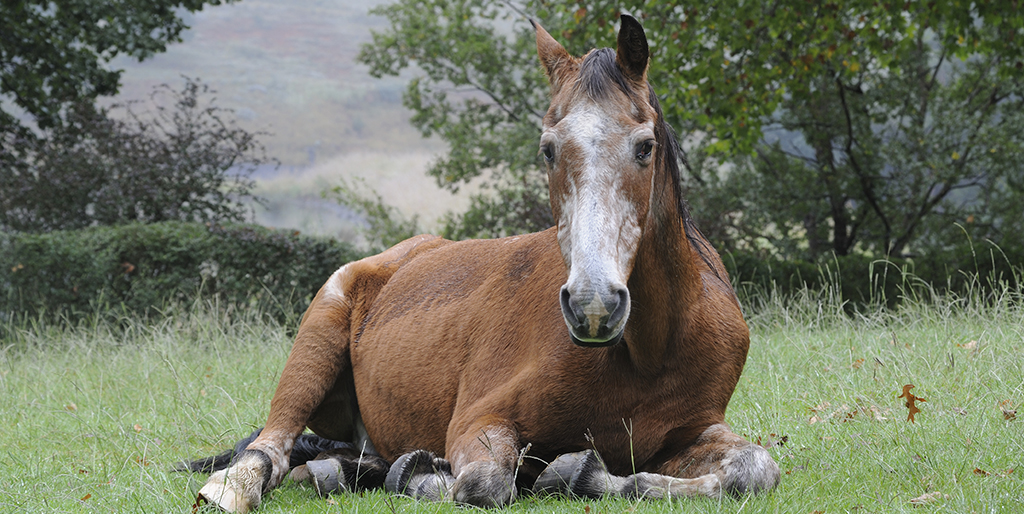
Study reveals insights into tendon injury risk
Researchers identify link to reduced blood supply.
Researchers have identified a link between reduced blood supply in ageing horses and higher risk of tendon injuries.
A study led by researchers at the Royal Veterinary College provides vital insight into why older horses and people are more prone to tendon injuries, and why these injuries heal more slowly and less effectively.
The research, published in Aging Cell, will help vets and trainers identify horses at higher risk of injury and select the most appropriate treatment and rehabilitation strategies.
Dr Nodoka Iwasaki, Postdoctoral Researcher at the RVC, said: “We found that older tendons lose many of their larger blood vessels, which are crucial for repair and recovery.
“This helps explain why older horses are more prone to tendon injuries and why these injuries heal more slowly. We are now exploring ways to prevent this age-related decline, with the aim of improving outcomes for older horses diagnosed with tendon injury”.
In the study, the team used advanced 3D imaging to capture detailed images of tendon tissue from young and older horses. Specifically, the examined blood vessels within the superficial digital flexor tendon (SDFT), similar to the human Achilles tendon and one commonly injured in athletic horses.
The images revealed a 70 per cent reduction in overall vascular volume in older horses, meaning there was far less blood present within the tendon’s blood vessels. They also revealed a 30 per cent decrease in vessel diameter and a 74 per cent reduction in blood vessels overall, compared to younger horses.
This means older tendons receive far less blood flow, making them more vulnerable to damage and will be slower to heal.
Chavaunne Thorpe, a lecturer in basic sciences at the RVC’s department of comparative biomedical sciences, said: “Using high-resolution 3D imaging techniques, we have shown that the blood supply to the injury prone superficial digital flexor tendon is dramatically altered as horses age, with a loss of larger blood vessels.
“This may explain why older horses are more at risk of tendon injury, as a lower blood supply means their tendons won't be able to heal as well. We are currently developing methods to prevent this age-related decline, which, if successful, may improve prognosis in older horses diagnosed with tendon injury."
Image (C) Wolf Avni/Shutterstock.

RSPCA welcomes dog breeding assessment tool
The Royal Society for the Prevention of Cruelty to Animals (RSPCA) has supported the launch of a new tool designed to tackle extreme breeding practices.
The Innate Health Assessment (IHA), created by the Royal Veterinary College, acts as a visual checklist of 10 key conformational features which can cause suffering to affected dogs.
It is hoped that the new tool will tackle breeding practices which exaggerate the extreme features, often in so-called ‘designer dogs’. This includes flat faces, wrinkly skin, short or missing tails and protruding eyeballs.
Such features contribute to health and welfare issues for dogs, impacting their day-to-day life and causing spinal, skin and dental conditions.
The IHA is free to access online, and can be performed by dog breeders and prospective owners. The checklist acts as a visual guide, assessing the extent to which dogs display exaggerated physical features that could harm them or their future offspring.
Dogs which pass at least eight of the 10 criteria set out in the IHA would be considered as having suitable conformation for breeding.
Among the criteria that breeders and dog owners are advised to check for are skin folds, bowed legs and bulging eyes.
The tool is expected to help breeders make appropriate dog selections, as well as educating prospective owners on the conformational health of their new dog or its parents. Meanwhile, for current dog owners, the guide could raise awareness of their dog’s health risks and alert them of issues to monitor at veterinary appointments.
Its release comes as the RVC shares new research, revealing a significant increase in surgical interventions relating to extreme conformation breeds.
The study revealed a 2,075 per cent rise in soft-tissue surgical referrals for French bulldogs. There was also an 800 per cent increase in surgeries to manage breathing problems in flat-faced breeds.
However, in a separate study conducted earlier this year, RVC found that dog owners in the UK preferred less extreme body shapes in flat-faced dogs.
Ashleigh Brown, scientific and policy manager in the RSPCA’s Companion Animal Department, said: "The IHA is a valuable tool providing a means to empower owners and breeders to make well-informed decision-making on this issue.
“This initial launch is an important first step, and evolution of the tool and ultimately incorporation into breeding licensing protocol is what we are still working towards over the longer term to further improve the lives of our much-loved pets. “We commend the work of Dan O’Neill and APGAW in advancing the IHA concept to this stage, and the RSPCA remains committed to continuing to support this going forward.”
The Innate Health Assessment tool can be found here.
Image © RSPCA
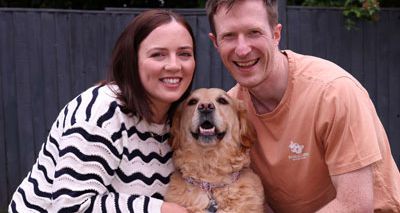
Charity honours hero dog who saved owner's life
Polly will be recognised as a 'CPR hero' in London.
A golden retriever who helped save the life of his owner, Adam, who suffered a cardiac arrest will be honoured at a prestigious award ceremony.
Four-year-old Polly’s barking woke Adam’s wife, Hannah, who performed life-saving CPR and contacted the emergency services.
Both Polly and Hannah will be celebrated at the British Heart Foundation’s Heart Hero Awards, taking place in London tonight (25 November). The star-studded event takes place at the Bloomsbury Ballroom and will see Polly and Hannah receive ‘CPR Heroes’ awards for their actions.
Hannah, 33, describes how she was awoken in the middle of the night by Polly’s barking:
“Polly would bark the odd time if she hears anything as she sleeps in the kitchen which is directly below our bedroom," she said. "She’s very in tune with Adam, and when she barks I usually turn to Adam to tell him. That’s when I suddenly realised he was breathing very noisily.
“When I heard the noise Adam was making I sat bolt upright in bed as I previously worked as a carer and it hit me that it was the same noise I’ve heard when people are taking their final breaths.”
Hannah added: “Polly alerted me, possibly within seconds of Adam’s cardiac arrest, she was the first responder. Because of her, I was able to start CPR almost immediately. The paramedics and first responders were amazing, they arrived so quickly and took action immediately.”
The paramedics worked tirelessly, shocking Adam seven times between his house and the hospital before they could get his heart rate normalised. He woke up six days later in hospital.
A keen runner, Adam was just 37 years old when he suffered his cardiac arrest. He spent three and a half weeks in hospital before he was fitted with an ICD (Implantable Cardioverter Defibrillator) and discharged.
Adam said: “When I was in hospital, we enquired about bringing Polly in but there was a no dogs policy. However, from my room I could see out onto the grass, so my dad would bring Polly and his boxer dog Xena up and show them where I was. Seeing them both really lifted my spirits.
“When I got out of hospital, I’ll never forget seeing Polly again and knowing how she had intervened that night. I just cuddled her and cried for 20 minutes”.
Adam and Hannah say the experience has given them “a new perspective” and a “second chance of life”, and are delighted to be welcoming their second child next year.
Fearghal McKinney, head of British Heart Foundation said: “This wonderful family and what they’ve been through are exactly what the Heart Hero awards are about and demonstrates the importance of life-saving CPR and defibrillation. If Polly hadn’t barked, Hannah hadn’t woken, then the outcome of this story could potentially have been entirely different.”
He added: “And now they’re celebrating a new life together, what a privilege it is to be able to honour both Hannah and Polly’s incredible actions with a CPR hero award.”
Image (C) British Heart Foundation.
